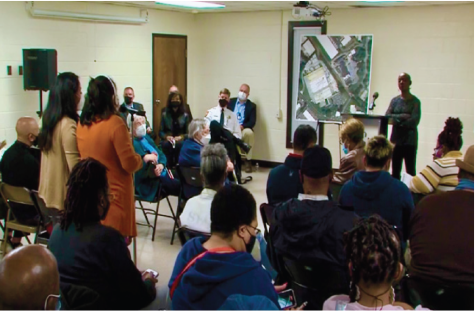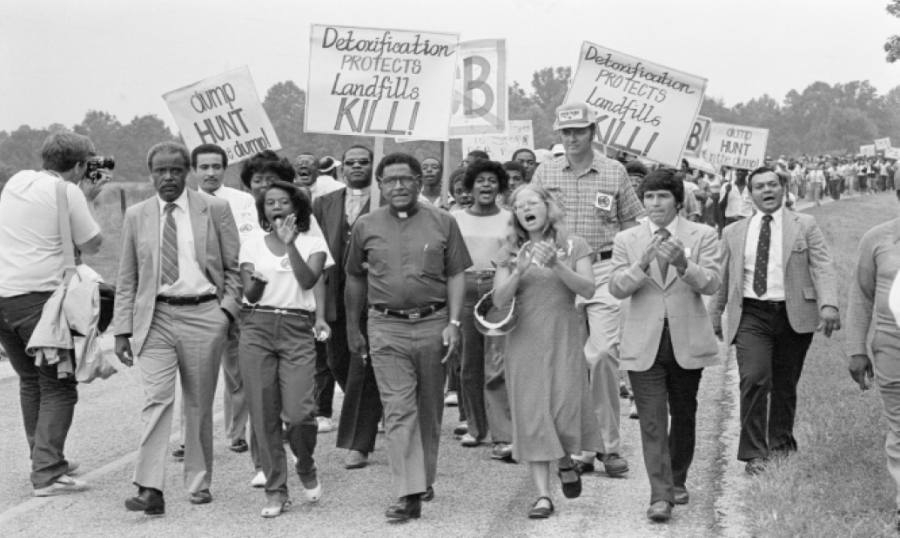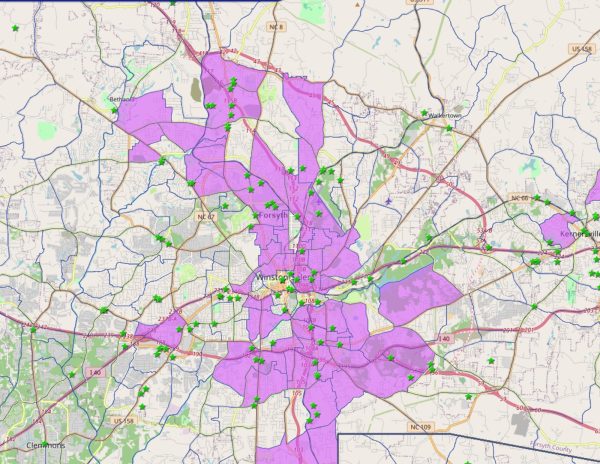Past and present: Moving toward environmental justice
How environmental research and injustice is tied to North Carolina and Winston-Salem
In the birthplace of the environmental justice movement, protesters march against the proposal of a PCB landfill in a predominantly Black neighborhood in Warren County, N.C., in 1982.
March 2, 2023
Day after day in America, pollutants are pumped into the atmosphere, toxic chemicals are poured into water sources and hazardous waste is buried within our soil. Many communities across the nation suffer from the toxic human activities that fuel the destruction of the environment. As research unfolds, a pattern has emerged between those who suffer regularly from environmental hazards and those who are secluded from them. The difference lies in the fundamental structures of American society and policy that are rooted in discrimination and prejudice.
Research has found that toxic hazards disproportionately impact Black and low-income communities in the United States, causing an increase in health issues within these communities. This correlation sparked a national movement to combat discriminatory environmental injustices: the environmental justice movement. Today, the fight for environmental justice continues across the country, including within the city of Winston-Salem and at Wake Forest University.
Environmental justice is a broad term that can have many meanings. According to Dr. Corey D.B. Walker, the director of the Wake Forest African American Studies Program, “Environmental justice is the idea that regardless of who you are, regardless of your nationality or your identity, regardless of your income, everyone should have the right to a fair and equitable environment that enables them to live to the fullest of their potential and to contribute meaningfully to society.”
Environmental justice is the idea that regardless of who you are, regardless of your nationality or your identity, regardless of your income, everyone should have the right to a fair and equitable environment that enables them to live to the fullest of their potential and to contribute meaningfully to society.
— Corey D. B. Walker, Interim Dean of Divinity, Wake Forest Professor of the Humanities and Director of African American Studies
The Piedmont Environmental Alliance (PEA), an environmental advocacy organization in Winston-Salem, defines environmental justice as “the fair treatment and meaningful involvement of all people regardless of race, color, national origin or income with respect to the development, implementation and enforcement of environmental laws, regulations and policies. In simpler terms, it means that everyone gets an equal chance at a healthy life and a healthy environment.”
The birth of the modern environmental justice movement began in 1982 in Warren County, N.C., where a small, predominately Black and poor town staged large protests against the dumping of toxic chemicals in the area. Despite ultimately losing the battle, these protests demonstrated the collective power of affected communities and sparked the beginning of environmental justice research.
In 1987, the United Church of Christ’s (UCC) Commission for Racial Justice published the first study of toxic waste facility sites in relation to racial demographics titled “Toxic Waste and Race in the United States.” Its findings concluded that race is the most significant independent variable correlated with communities chosen as sites for toxic waste facilities and hazardous disposals.
Benjamin Chavis, the author of the report and former Executive Director of the UCC’s commission, coined the term “environmental racism” based on the racial disparity found in this research study.
While there are many definitions of the term today, Walker defines environmental racism as “Discrimination and disregard for African American communities by choosing them as sites for toxic dumps, choosing them as sites for less adequate infrastructure, sites for highly polluted air, sites close to where interstates are located and sites where adequate housing and ventilation are not available.”
As the environmental justice movement seeks to dismantle these inequalities, Walker emphasizes that environmental racism is not a simple issue to solve. America’s history of segregation, redlining, disinvestment and negligence of Black and minority communities embeds this form of racism into the very fabric of urban planning and affects how we conceptualize inequality.
“Racism is not just some innate feeling of superiority. Racism is built into the very environment in which we live,” Walker said. “Environmental racism is not a quick fix. Instead of finding the racist in the room, we must look at the very systems that are legitimated, that are authorized, and that are organized, which continue to perpetuate [environmental inequality] in a manner that the lives and life chances of those marginalized communities are deemed less worthy.”
City construction in Winston-Salem reveals the ways in which structural racism influences societal design, segregation and subsequent environmental impacts.
According to the think tank New America, Winston-Salem has a wide gap of income inequality among its residents, demarcated by its very design. The construction of U.S. Route 52 divides city populations by wealth and race, as “census tracts to the west of the highway are predominately white and wealthy, while the low-income tracts to the east are overwhelmingly Black and Latinx.”
Walker points to this city design as a clear demonstration of the disproportionate locations of environmental hazards.
“In our contemporary moment, you can look at those targeted areas [of environmental injustice] in Winston-Salem. There’s off-gassing on Martin Luther King Avenue. There are cancer clusters in east Winston-Salem. There are high incidences of particulate matter that flow through Winston- Salem State University because the residence halls are on a major highway,” Walker said.
According to Walker, these areas that experience such environmental effects are predominantly Black and lower-income, as compared to wealthier and predominantly white areas of the city that do not face frequent occurrences of environmental hazards.

This racial segregation within the city further fuels environmental injustices that harm Black communities in Winston-Salem. The location of the Winston Weaver Co. fertilizer plant exemplifies this issue, as between 81% and 85% of surrounding residents are people of color. When the fertilizer plant erupted into flames in January 2022, the chemically hazardous threat of the fire and its explosive potential directly impacted these nearby residents, creating a disproportionate threat toward people of color.
Organizations within Winston-Salem are expanding these conversations of environmental injustice and racism in an effort to achieve environmental justice and equality throughout the city. The Piedmont Environmental Alliance has hosted community discussions about environmental justice and educates young students in Winston-Salem. The Yadkin Riverkeeper employs advocates for environmental justice in water pollution, and grassroots groups fight for reparations for hazards like the Weaver fertilizer fire.
According to Walker, universities such as Wake Forest contribute to the efforts of environmental justice through scholarship.
“The university creates certain knowledge,” Walker said. “We’re trying to expand the boundaries of knowledge to say that the environment is not an afterthought; it is at the very core of how we not only live but how we think and respond to others in the world. We are developing humane intellectual structures that then recognize the centrality of our planetary inheritance.”
As Wake Forest expands its development of environmental justice seminars and research through the Environmental Justice Mellon Grant, the university will continue to develop and investigate these structures of knowledge necessary for establishing environmental justice within Winston-Salem and throughout the country.





















Danny Petty • Mar 26, 2023 at 7:13 am
We grew up in Morningside Homes in Greensboro, N.C. and our church was located at the corner of Spencer Street and Bingham Street adjacent to Bingham Park. For years we smelled emissions from Buffalo Creek, Lorillard and God only knows what else was in the air. Many times we played in that park, used it as a short cut and never had any idea of what was going on beneath our feet. This is extremely appalling!!!! Many people have passed away over the years and I wonder if our health issues are related to the environment we lived in all those years.